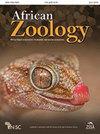黄褐色粗尾蝎两性异形及细尺度空间分布描述
IF 0.5
4区 生物学
Q4 ZOOLOGY
引用次数: 4
摘要
南部非洲包含了一个多样化和地方性的蝎子动物群,但在生物学方面,这一群体仍未被探索。为了深入了解一种未被充分研究的蝎子物种,本研究调查了南非特有的褐皮厚尾蝎子(Parabuthus planicauda)的精细尺度空间分布和性别二态性。该物种密切跟踪岩石地区,性别均匀分布在栖息地。不同的成人性别比例在每个采样区都很明显,可能受到不同植被覆盖和捕食压力的影响。当考虑尺寸校正后的测量结果时,平头拟鱼的几个性状具有显著的两性二态性;基于未校正的测量,这种性别二态性不容易观察到(小于10%的大小差异),从而使得在野外识别雄性和雌性变得困难。即便如此,雌性的两性二态特征似乎主要是由自然选择形成的(例如甲壳宽度、肢髌骨和瘤),可能是为了提高喂养能力、繁殖力、亲代照顾和幼崽存活率。相比之下,雄性的形态可能主要受求爱和交配过程中使用的特征(如果胶、螯、活动手指、肢端股骨、第二和第四腿)的性选择压力的影响。综上所述,本文报告的结果为南非特有蝎子物种的生物学方面的研究提供了新的初步信息。本文章由计算机程序翻译,如有差异,请以英文原文为准。
Describing Sexual Dimorphism and Fine Scale Spatial Distributions in the Drab Thick-Tail Scorpion, Parabuthus planicauda
Southern Africa contains a diverse and endemic scorpion fauna, but with biological aspects remaining largely unexplored for this group. In order to gain biological insights into an understudied scorpion species, the current study investigates fine-scale spatial distributions and sexual dimorphism in the South African endemic Drab Thick-tail Scorpion (Parabuthus planicauda). The species closely track rocky areas, with the sexes homogenously distributed across habitats. Varying adult sex ratios are evident at each sampling area, likely influenced by differing vegetation cover and predation pressures. When considering size-corrected measurements, several characters are significantly sexually dimorphic in P. planicauda; this sexual dimorphism is not readily observable (<10% difference in size) based on uncorrected measurements, thereby rendering the identification of males and females in the field difficult. Even so, sexually dimorphic characters in females appear to be shaped mainly by natural selection (e.g. carapace width, pedipalp patella and metasoma), likely for enhanced feeding ability, fecundity, parental care and juvenile survival. In contrast, the male morphology may be primarily subject to sexual selection pressures on features used during courtship and mating (e.g. pectines, chela movable finger, pedipalp femur, 2nd and 4th legs). Taken together, the results reported on here add novel preliminary information on the understudied biological aspects of a South African endemic scorpion species.
求助全文
通过发布文献求助,成功后即可免费获取论文全文。
去求助
来源期刊

African Zoology
生物-动物学
CiteScore
2.60
自引率
9.10%
发文量
18
审稿时长
>12 weeks
期刊介绍:
African Zoology , a peer-reviewed research journal, publishes original scientific contributions and critical reviews that focus principally on African fauna in terrestrial, freshwater, and marine ecosystems. Research from other regions that advances practical and theoretical aspects of zoology will be considered. Rigorous question-driven research in all aspects of zoology will take precedence over descriptive research. The Journal publishes full-length papers, critical reviews, short communications, letters to the editors as well as book reviews. Contributions based on purely observational, descriptive or anecdotal data will not be considered.
The Journal is produced by NISC in association with the Zoological Society of South Africa (ZSSA). Acceptance of papers is the responsibility of the Editors-in-Chief in consultation with the Editors and members of the Editorial Advisory Board. All views expressed are those of the author and not necessarily those of the Editors or the Department.
 求助内容:
求助内容: 应助结果提醒方式:
应助结果提醒方式:


